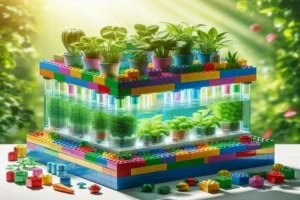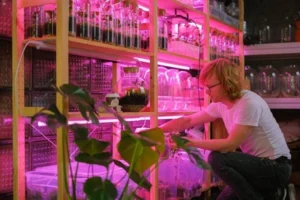Hydroponic gardening has gained a lot of attention in recent years, especially among apartment dwellers looking for a way to grow fresh produce indoors. This method allows you to grow plants without soil, using a nutrient-rich water solution to nourish them. It’s a space-efficient and sustainable solution, making it ideal for people who want to bring a bit of greenery into their home, even when space is limited.
Living in an apartment comes with its own set of challenges when it comes to gardening. Small spaces, lack of outdoor areas, and minimal natural light can make it feel impossible to grow your own food. That’s where hydroponics comes in. By using vertical systems or compact setups, you can maximize every inch of available space, growing herbs, leafy greens, and even small vegetables right inside your apartment.
The purpose of this article is to help you navigate the world of hydroponic gardening and choose the best system for your apartment’s limited space. Whether you’re a complete beginner or looking to expand your indoor garden, we’ll walk you through the factors to consider and explore the best options for small-scale hydroponic systems that fit your living situation.
Choosing the Right System
When it comes to hydroponic gardening in small apartment spaces, selecting the right system is key to ensuring success. With so many options available, it can be a bit overwhelming to decide which system will work best for your needs. The good news is that by considering a few key factors, you can choose the right setup that fits your space, lifestyle, and gardening goals. Let’s dive into these important considerations and explore the best hydroponic systems for small spaces.
Key Factors to Consider
Before choosing a hydroponic system, there are a few factors to consider that will help you determine the best fit for your apartment.
- Available Space
Space is perhaps the most important consideration when setting up a hydroponic garden in an apartment. Some systems are designed to maximize vertical space, while others are more compact and suited to tight corners or windowsills. Take a close look at the available space in your apartment—whether it’s a small kitchen countertop, a corner in your living room, or a section of your balcony—and decide how much room you’re willing to dedicate to your hydroponic garden.
If you’re dealing with extremely limited space, systems that can be stacked or suspended will be a better choice, allowing you to grow vertically rather than horizontally.
- Light Requirements
Light is crucial for plant growth, and the amount of natural sunlight available in your apartment will influence your system choice. Hydroponic gardens, like any garden, need sufficient light to thrive. If you have a lot of natural light coming in through your windows, you may be able to rely solely on that. However, if your apartment has limited natural light (or if you want to grow plants in a room with little to no sunlight), you’ll need to consider installing grow lights.
Some hydroponic systems come with integrated lighting, while others require you to buy lights separately. Consider your light sources carefully, as well as how much light different plants need. For example, leafy greens like lettuce and spinach generally require less light than fruiting plants like tomatoes or peppers.
- System Size
The size of the system is another factor to think about. Some hydroponic systems are designed to fit on a small kitchen countertop, while others are larger, floor-standing units. It’s important to choose a system that fits comfortably in your available space without feeling cramped or crowded.
If you’re looking to start small and gradually expand, modular systems or those with stackable trays might be the best option, as they allow you to add more layers or sections as your gardening needs grow. On the other hand, if you’re looking for a more compact, one-unit solution, a smaller vertical tower system could be the way to go.
- Ease of Maintenance
Hydroponic systems require a bit of attention and maintenance, but some are easier to care for than others. Systems that use water recirculation are ideal for low-maintenance gardeners because they minimize the need for frequent water changes. On the other hand, systems that use larger reservoirs or have a more intricate setup might require more time and attention.
Consider how much time and effort you’re willing to put into maintaining your hydroponic garden. If you’re looking for a hassle-free option, self-watering or automated systems might be a good choice, as they simplify the process. For those who enjoy the process of gardening and don’t mind some hands-on maintenance, a more traditional system may suit your needs.
Recommended Hydroponic Systems
Now that you know the key factors to consider, let’s look at some of the best hydroponic systems for small spaces. Each of these options has its own set of advantages, so the best choice will depend on your available space, time commitment, and gardening goals.
- Vertical Hydroponic Systems
Vertical hydroponic systems are a popular choice for apartment dwellers because they maximize vertical space, making them perfect for tight living areas. These systems are designed to stack plants in multiple layers, with water circulating between them. Vertical towers or shelving units often have a small footprint but provide plenty of room for growing a variety of plants.
Many vertical systems are self-contained, meaning they’re easy to set up and maintain. Some even come with built-in grow lights, so they’re ideal for areas with limited natural light. Vertical systems are great for growing leafy greens like lettuce, spinach, and kale, as well as herbs such as basil and cilantro.
- Compact Modular Units
Modular hydroponic systems are another fantastic option for small spaces. These systems are often stackable or can be expanded as needed, so you can start with a small unit and add more layers or sections over time. They’re perfect for anyone who’s looking for flexibility and the ability to expand their garden in the future.
Modular units are available in a variety of designs, from countertop setups to freestanding units. Many of them are simple to set up and require minimal maintenance, making them a great choice for beginners. Plus, they allow you to grow a wide range of plants, from herbs to compact vegetables.
- Window Farms and Hanging Planters
For the most space-efficient option, window farms and hanging planters are a great way to grow plants using your apartment’s natural light. These systems can be suspended from a windowsill or hung from the ceiling, allowing you to grow plants vertically in front of a window or in areas with limited floor space. Window farms typically use a combination of vertical planters and a water reservoir to keep the plants hydrated.
While these systems are great for small herbs and leafy greens, they might not be the best choice for larger plants like tomatoes or cucumbers, which need more space to grow. However, they’re a fantastic way to bring greenery into your apartment without taking up much room.
- Self-Watering Systems
If you’re looking for convenience and minimal maintenance, self-watering systems are worth considering. These systems typically include a water reservoir and a wicking mechanism that delivers water to the plants as needed. Some self-watering systems are designed to work with hydroponics, while others are soil-based but still use the same principle of automatic water delivery.
These systems can be especially helpful for people with busy lifestyles, as they require less attention and are more forgiving if you forget to water them. For small spaces, self-watering systems that integrate both growing and water management into one unit are a great option for low-maintenance gardening.
Best Plants for Small Hydroponic Gardens
Choosing the right plants is essential for the success of your hydroponic garden, especially in a small space. Some plants thrive in hydroponic systems and grow well in limited space, while others may require more room to spread out. Here are some of the best options for small hydroponic gardens:
- Leafy Greens
Leafy greens like lettuce, spinach, kale, and arugula are ideal for small hydroponic gardens. They don’t require a lot of space to grow, and they thrive in hydroponic systems. These plants also grow quickly, meaning you’ll have a steady supply of fresh greens without taking up much room. Vertical systems are perfect for leafy greens, as you can grow multiple varieties in a small area.
- Herbs
Herbs are a great choice for apartment hydroponic gardens because they don’t require much space and can be grown in almost any hydroponic setup. Basil, mint, parsley, cilantro, and thyme are just a few examples of herbs that do well in hydroponic systems. You can grow a variety of herbs in small vertical or modular units, and they’re perfect for adding flavor to your cooking.
- Compact Vegetables
If you’re looking to grow vegetables, focus on compact varieties that are well-suited to hydroponic systems. Small tomatoes, peppers, and cucumbers can thrive in vertical hydroponic systems, as long as you provide adequate support for their growth. Compact vegetables are a great choice if you want to grow something other than leafy greens and herbs, but keep in mind that they may require more attention and space than smaller plants.
Conclusion
Choosing the right hydroponic system for your apartment’s limited space doesn’t have to be overwhelming. Start small, experiment with different systems, and see what works best for you. Whether you choose a compact modular unit, a vertical system, or a self-watering setup, each option offers a chance to grow your own food right inside your home.
Hydroponic gardening allows you to enjoy the benefits of fresh, sustainable produce without the need for large outdoor space. It’s a great way to have access to healthy greens, herbs, and even small vegetables year-round, all while minimizing your environmental impact. Plus, it’s a rewarding experience that connects you with nature, even in the middle of the city.
Taking that first step toward hydroponic gardening might feel intimidating, but it doesn’t have to be. Start with a small system, and gradually expand as you get more comfortable with the process. Each success along the way will build your confidence, and soon enough, you’ll be enjoying your homegrown harvest.
By embracing hydroponics, you’re not just growing food—you’re embracing a more sustainable lifestyle. You’re reducing waste, saving water, and lowering your carbon footprint. So, why not give it a try? Take the first step, and discover the joy of growing fresh food in your own apartment.




